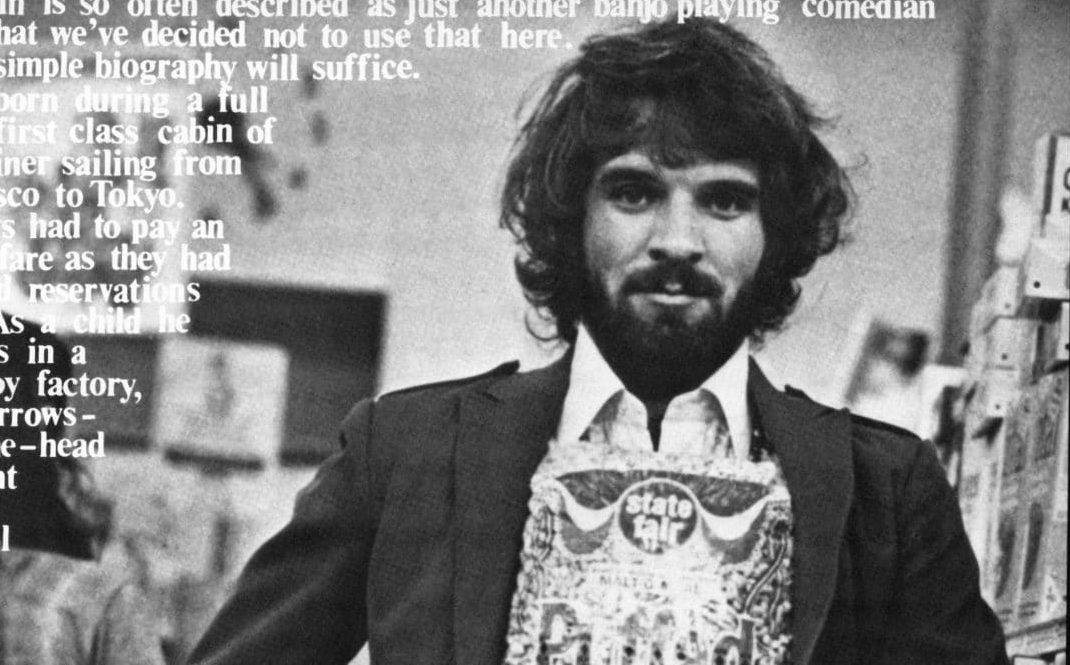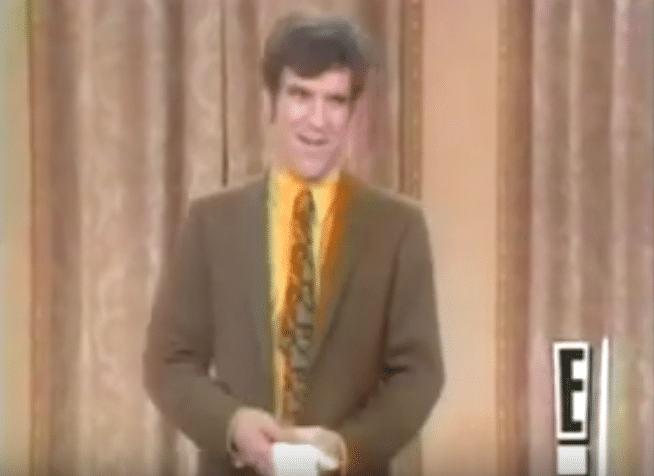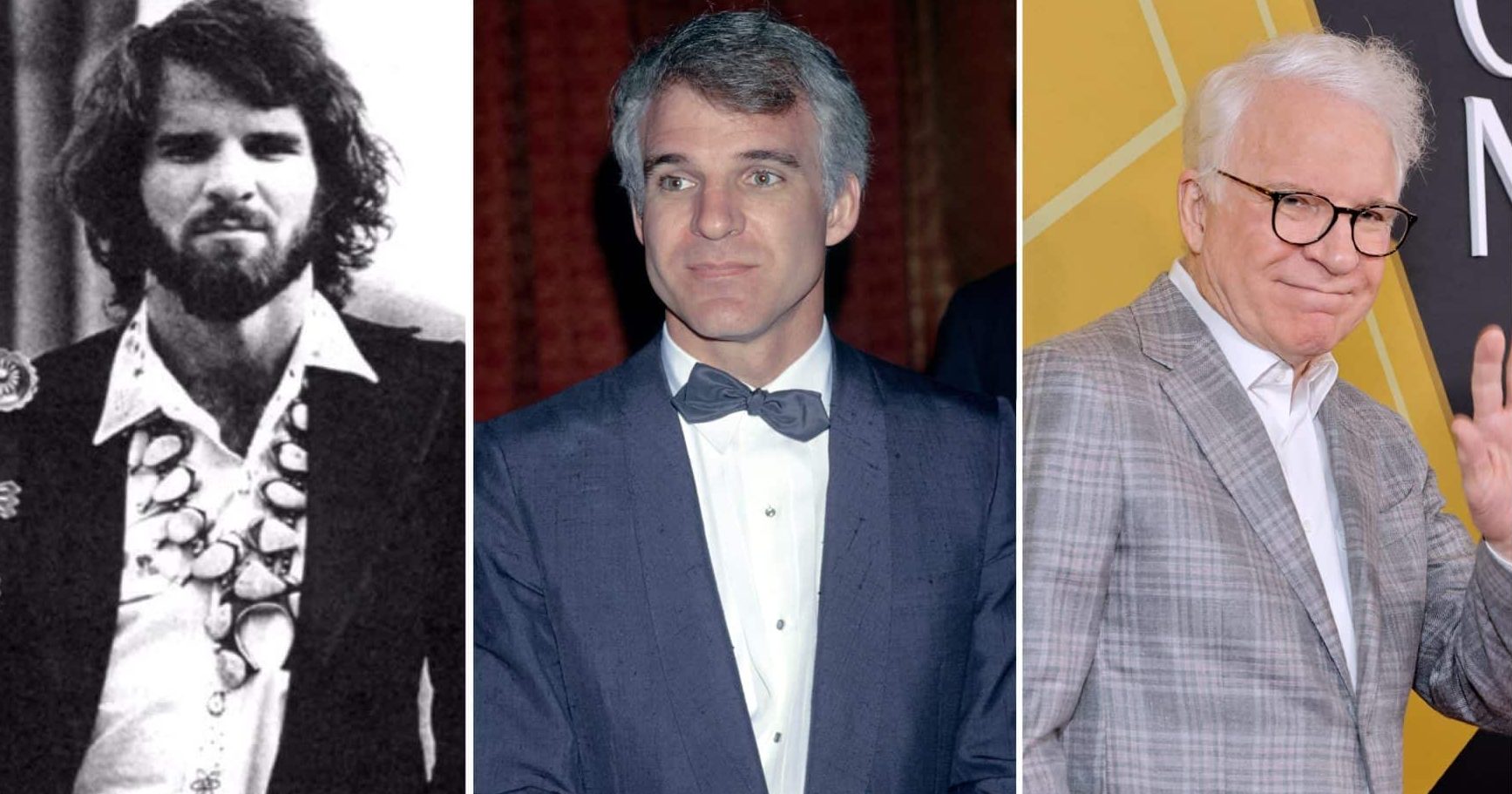For going on five decades, Steve Martin has been a superstar comic. The lead of hit comedy movies including The Man with Two Brains, Father of the Bride, Cheaper by the Dozen and The Pink Panther, today Martin stars in popular TV show Only Murders in the Building, alongside Selena Gomez and longtime pal Martin Short. What’s remarkable is that, through all those projects down the years, Martin’s signature look has hardly changed.
Though in his 20s he sported long dark hair, Martin went grey prematurely, his hair turning completely white by his early 30s. While the comedian himself has been reluctant to talk about it, others have put Martin’s early hair colour change variously down to genetics, stress and an encounter with some life-changing narcotics.

“A celebrity is any well-known television or movie star who looks like he spends more than two hours working on his hair,” Steve Martin once quipped. Born on August 14, 1945, Martin was raised in Inglewood and Garden Grove, California where, from an early age, he seemed destined to stand out.
In his teenage years, Martin took up the banjo – an instrument he still plays in concerts to this day – and was a high school cheerleader. At the time, Martin wrote in his 2007 memoir Born Standing Up, “My look was strictly wholesome Baptist”, but this quickly changed once he left school.
When he arrived at college, Martin “switched to cotton pants called peggers, because I had vowed to grow up and abandon jeans”. As the 60s rolled on, Martin adopted a countercultural look: “I used to wear long coats,” he told New York Magazine in 1977. “I had long hair and I wore turquoise necklaces and concho belts.”

As a young club comedian, Martin grew out a long beard and wild, straggly hair. His locks were brown at that time – but his current appearance began to take shape as his profile rose.
Nightclub owner Paul Colby has detailed Martin’s early transformation from wild hippie to distinguished fatherly figure. “[His act] didn’t jibe with the way he looked,” Colby noted. “I know that David Brenner took him aside and gave him the best advice Steve Martin ever got.”
“David told Steve to clean up, shave the beard, cut the hair, and dress up,” he elaborated. “It’s an old lesson, but if a poor pushcart vendor falls down an open manhole, it’s tragic. If a guy in a tuxedo falls down the same manhole, it’s funny. That was when Steve adopted the white suit.”

Martin, meanwhile, has said he changed from a hippie look to a more strait-laced look because he wanted to distance himself from what the free love movement had turned into. He described this change as a “crucial decision” in his career.
In 2008, Martin said to NPR: “The Vietnam War was raging, but it was winding down. And I just sensed that the era was ending, that it – it was a kind of – I don’t like this word, but an implosion because you just can’t keep taking drugs and have a philosophy live on. I mean, people are dying. And Charles Manson came on the scene and besmirched everyone with long hair. And so I decided, OK. I’m putting on a suit, I’m putting on a tie, and I’m cutting my hair.”
Martin’s newfound formal look was quite an adjustment. He later admitted that he felt humiliated sporting his new haircut for an early TV appearance on The Virginia Graham Show, in 1970.
“I looked grotesque,” Martin has said. “I had a hairdo like a helmet, which I blow-dried to a puffy bouffant, for reasons I no longer understand. I wore a frock coat and a silk shirt, and my delivery was mannered, slow and self-aware. I had absolutely no authority. After reviewing the show, I was depressed for a week.”

White hair was always on the horizon for Martin. He found his first grey hair at 15, according to a 1977 interview with journalist Tom Shales.
Steve Martin’s best friend from childhood, Morris Walker, has corroborated this, noting that Martin’s hair change was a genetic quirk.
“The truth of the matter is that for as long as I’ve known Steve’s family, his mother and father also had gray (now white) hair,” Walker has written. “It’s just a Martin family trait.”
Others had their own theories. “I remember one of Steve’s girlfriends, Teri Garr, telling me about a rare night some years later,” noted Walker. “Steve was quite freaked out while he was stoned on some rather potent pot, and she said he looked like he had seen a ghost. She thought his hair color changed to white more rapidly after that experience.”
Meanwhile, in 1977, Rolling Stone magazine claimed Martin’s hair had started turning grey due to performance-related stress: “Steve Martin’s thirty-two-year life has not been pretty. Already it has turned his hair prematurely gray, a condition likely to remain for some time. Already it has burdened him with the reputation of a reckless crazyman who would do literally anything for a laugh.”

By his early 30s, Martin’s hair was already almost entirely white. In 1976 Martin, aged just 31, made his debut as Saturday Night Live host – a position he would take a further 15 times – already sporting the greying hair that would become his signature look.
As an actor, Martin has changed his hair on many occasions. In The Muppet Movie (1979), The Jerk (1979), Dead Men Don’t Wear Plaid (1982), Little Shop of Horrors (1986) and My Blue Heaven (1990), Martin utilised varying amounts of dark hair dye (and possibly hairpieces) to achieve different looks.
Martin reportedly auditioned to play Indiana Jones in Raiders of the Lost Ark (1981), before the role was won by Harrison Ford – another grey-haired celebrity who bears some resemblance to Martin. By the time he made the hit comedy Planes, Trains and Automobiles (1987) alongside John Candy, Martin fully embraced his natural white hair.
Martin knows that his white locks make him an easily identifiable celebrity – and so when he planned an incognito trip to Disneyland, USA (where he worked as a teenager), his hair was the most important thing to hide.
“Recently I went back in a disguise,” he has reminisced. “I dyed my hair brown and wore a brown mustache. It’s not that people mob me on the streets; but Disneyland can be very tough, and I don’t like being stared at or yelled at.”

Though Martin has rarely spoken of his vivid hair colour, he’s not ashamed to joke about the other aspects of an aging appearance.
On the topic of thinning hair, Martin has noted: “It’s a funny thing, hair. Just when it seems you’re destined to go bald on top, it starts growing out your nose. It’s like the hair is still in your head, but decides it’s time to pop out for a breather elsewhere.”

